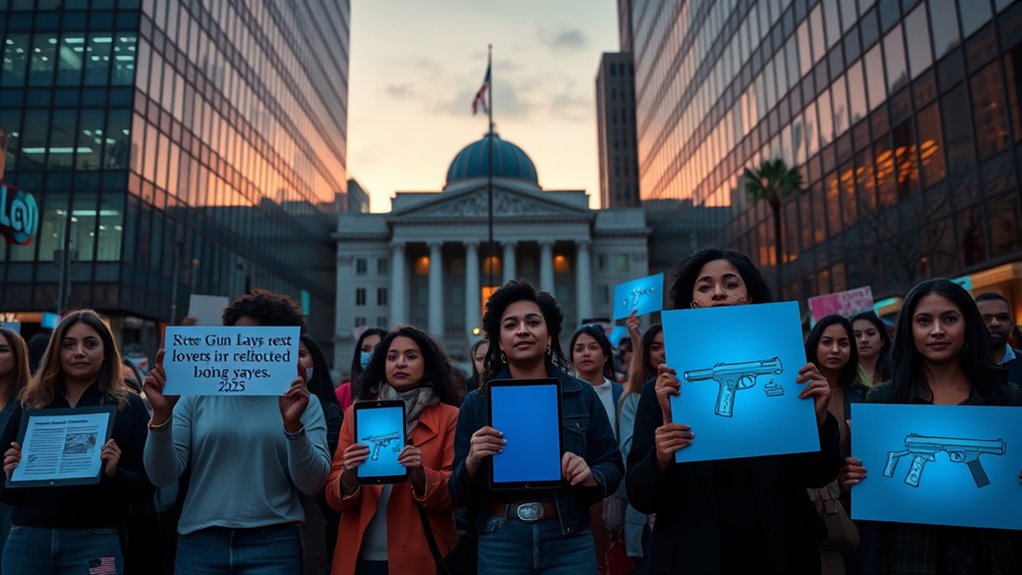In 2025, gun laws have expanded to include thorough background checks for all sales, tighten restrictions on assault weapons, and promote responsible ownership through safety training and secure storage. Electronic databases help guarantee faster, more detailed screening, while ongoing debates focus on balancing individual rights with public safety. If you’re curious about how these laws impact communities and ongoing legislative efforts, there’s more to uncover about the evolving landscape of gun control today.
Key Takeaways
- Most private and online gun sales now require background checks, closing previous loopholes and streamlining the process.
- Laws have been updated to regulate assault weapons and high-capacity magazines more strictly.
- Electronic databases and real-time systems enhance background check efficiency and prevent illegal sales.
- Public debates focus on balancing Second Amendment rights with safety measures like responsible ownership laws.
- Community programs emphasize safe storage, mandatory safety training, and responsible gun ownership to reduce incidents.

By 2025, gun control laws have evolved considerably, shaping the way communities, policymakers, and individuals approach firearm safety. You’re likely aware of ongoing debates surrounding the Second Amendment, which guarantees your right to bear arms, but recent legislative changes aim to balance this constitutional right with public safety concerns. One significant shift involves expanding background checks to close loopholes that previously allowed many firearms to be purchased without thorough scrutiny. Today, background checks are now required for nearly all gun sales, including private transactions and online purchases, making it harder for prohibited individuals—such as those with criminal records or certain mental health issues—to legally acquire firearms.
By 2025, background checks now cover nearly all gun sales, closing loopholes and enhancing firearm safety and responsible ownership.
This move toward universal background checks is driven by the recognition that thorough vetting can prevent firearms from falling into the wrong hands. You might have noticed that, in the past, private sales and gun shows often bypassed background checks, creating gaps in safety. Now, legislation mandates that anyone buying a firearm must pass a background check, regardless of where the purchase occurs. This change aims to reduce straw purchases and illegal trafficking, which have historically contributed to gun violence. While some argue that this infringes on Second Amendment rights, supporters contend that these measures are necessary to protect communities without undermining lawful gun ownership.
You may also see the legal landscape shifting to reinforce the Second Amendment while implementing sensible restrictions. For example, laws now specify which types of firearms and accessories are permissible, with stricter regulations on assault-style weapons and high-capacity magazines. These laws are often challenged in courts, but recent rulings have upheld the government’s authority to regulate firearms in the interest of public safety. As a gun owner, you’re encouraged to familiarize yourself with the new requirements, such as secure storage laws and mandatory safety training, which aim to promote responsible ownership.
Moreover, the focus on background checks has led to technological advancements that streamline the process. States are adopting electronic databases and real-time checks to speed up approvals and reduce errors. This ensures that background checks are thorough and efficient, preventing delays that might otherwise allow illegal sales to slip through. You might also notice more community programs aimed at safe storage and responsible gun use, emphasizing that gun ownership comes with ongoing responsibilities. Recognizing the importance of personality traits in responsible gun ownership can also help foster safer communities.
Frequently Asked Questions
How Have Gun Control Laws Impacted Crime Rates Since 2025?
Since 2025, gun control laws have generally helped lower crime rates, according to background statistics. You might notice fewer gun-related incidents in areas with stricter regulations, which enhances crime prevention. These laws make it harder for illegal gun sales and possession, contributing to safer communities. While some debates persist, data shows that stronger gun control measures positively impact overall safety and reduce violent crimes involving firearms.
What Are the Main Arguments Against New Gun Restrictions?
Imagine your Second Amendment rights as a shield protecting personal liberties. Opponents argue that new gun restrictions threaten this protection, potentially disarming law-abiding citizens and infringing on freedoms. They believe such laws don’t address crime effectively and may lead to government overreach. You’re told that preserving these rights guarantees you retain control over your safety and liberties, emphasizing that restrictions could undermine personal sovereignty and constitutional principles.
How Do Gun Laws Vary Across Different States and Regions?
You’ll notice that gun laws vary widely across states and regions due to differing state restrictions and regional disparities. Some states have strict regulations, requiring background checks and bans on certain firearms, while others maintain looser laws, allowing more access. These differences influence how easily you can acquire and carry guns depending on where you are, creating a patchwork of regulations that reflect local priorities and cultural attitudes toward gun ownership.
What Role Does Technology Play in Enforcing Gun Regulations?
Technology plays a vital role in enforcing gun regulations by implementing biometric verification and smart gun technology. You can guarantee only authorized users access firearms through biometric scans, reducing theft and misuse. Smart guns, equipped with safety features, prevent accidental discharges and unauthorized firing. These innovations work together, reinforcing security, promoting responsible ownership, and making gun regulation more effective. They transform enforcement by integrating advanced tech into everyday firearm use.
How Are Gun Owners and Advocacy Groups Responding to Recent Laws?
You see gun owners and advocacy groups actively responding to recent laws through protests and advocacy campaigns. Gun owner protests often draw attention to perceived infringements, mobilizing members to voice their concerns. Meanwhile, advocacy campaigns aim to influence public opinion and policymakers, either supporting or opposing new regulations. These actions demonstrate a dynamic, ongoing debate, as both sides seek to shape gun policy in ways that reflect their interests and values.
Conclusion
As you follow the evolving gun laws in 2025, remember that change often takes time and persistence. While debates continue, staying informed and engaged is essential. An old adage says, “The pen is mightier than the sword,” reminding us that dialogue and legislation shape our future. Keep your voice heard and your mind open—progress begins with understanding and action. Only then can we hope to balance safety and rights effectively.










